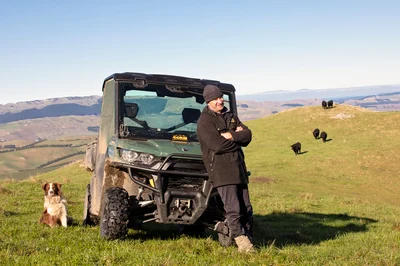Innovative approach to farming recognised

A majestic macrocarpa stag has appeared in the Scargill-Waikari Valley, delighting drivers on the peaceful North Canterbury country road.
The sculpture, carved by chainsaw by Blenheim-based artist Jakob Stadler, was commissioned by Iffley farm manager Scott Hassall.
"We had a tree that was causing problems with powerlines, so I thought we could do something with this instead of just chopping it down.
"I talked to the farm owner, and he agreed," Hassall said.

The stag represents the farm's deer operation and adds to the significant beautification of the property's road frontage, complemented by nearby native planting.
Sheep and beef are also integrated into the farm system, with 2200 sheep and 180 cattle running on the 940-hectare property.
The farm carries around 1000 hinds, which go to Wapiti stags sourced from John Faulkners Clachanburn stud.
Iffley runs Angus cattle and the family Charolais stud Hassall took over and moved to the property in 2016 after his father passed away.
The composite ewe flock on the farm carry the Inverdale fertility gene, which raises scanning rates by 50 per cent.
Hassall has managed Iffley along with his wife Jo for John and Pauline McGrath for over twenty years and approaches farming much the same way he approached the problem tree – with innovative thinking that explores possibilities and solutions outside the box.
Hassall was recently recognised for his innovation on-farm, winning the Duncan New Zealand Ltd award at the Deer Industry New Zealand Conference.
The award is given to deer farmers for vision and innovation whilst mastering a demanding environment.
The judges commended Hassall on his focus on environmental projects and in-depth knowledge of the whole farming system.
When the area was struck with drought three years ago, Hassall looked for a solution for utilising the established kale crops on the property and reducing feed costs.
"We were buying in around 300 bales of baleage, over 200 tonnes of spuds and about 6000 tonnes of grain.
"It was horrendous."
He came up with a unique solution.
Hassall fast-tracked the arrival of a new loading wagon designed for silage and set to work experimenting with the system with kale.
"I did a few rounds of kale with just my hay mower, then we went in with a load wagon and chopped a couple of wagons full."
The experiment was a success.
"What it meant was rather than just having one or two mobs behind break fences, I was able to chop that feed and take it all around the farm.
"I was able to feed every class of stock I have – cattle, dear, weaners, calves and sheep, so obviously, it was just awesome.
"Grass staggers stopped literally overnight because they just had some nice green feed all of a sudden."
Hassall said while using the system in this way wasn't for everyone, there are benefits to carting fresh feed over break feeding.
"It actually mitigates nutrient loss because there is no pugging and no breaks involved.
"The best part about the loader wagon is that it cuts big kale stalks into bite-size pieces, so there's no wastage.
"So when we are cutting and carrying, the paddock is just beautifully clean at the end of it.
"Stock love it."
Hassall takes a pragmatic approach to water quality that works with the deer's natural tendency to wallow in waterways but still ensures water exiting the property is clean.
"If you don't give deer somewhere to wallow, they'll just jump in a water trough and wreck that.
"Deer do well in their natural environment when they can do what they want to do.
"So, I've identified the exit points for water on the property and fenced those off."
By fencing and planting out exit points instead of fencing internally, Hassall ensures water leaving his property is clean.
"It's a really good compromise," Hassall said.
by Claire Inkson

